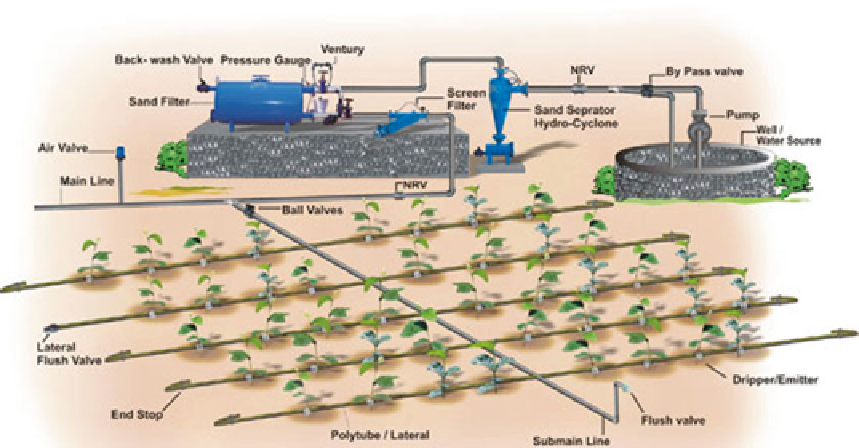Agriculture Reference
In-Depth Information
Fig. 12.10
A typical drip irrigation system
12.3.4.1 Advantages
Drip irrigation can help use water effi ciently.
A well-designed drip irrigation system reduces
water runoff through deep percolation or evapora-
tion to almost zero. If water consumption is
reduced, production costs are lowered. Also, con-
ditions may be less favorable for the onset of dis-
eases including fungus. Irrigation scheduling can
be managed precisely to meet crop demands, hold-
ing the promise of increased yield and quality.
Agricultural chemicals can be applied more
effi ciently and precisely with drip irrigation.
Since only the crop root zone is irrigated, nitro-
gen that is already in the soil is less subject to
leaching losses. In the case of insecticides, fewer
products might be needed. Fertilizer costs and
nitrate losses can be reduced. Nutrient applica-
tions can be better timed to meet plants' needs.
The drip system technology is adaptable to
terrains where other systems cannot work well
due to climatic or soil conditions. Drip irrigation
technology can be adapted to lands with different
topographies and crops growing in a wide range
of soil characteristics (including salty soils).
It has been particularly effi cient in sandy areas
with permanent crops such as citrus, olives, apples,
and vegetables. A drip irrigation system can be
automated to reduce the requirement for labor.
of the land topography on water pressure and
fl ow requirements. A plan for water distribution
uniformity should be made by carefully consider-
ing the tape, irrigation lengths, topography, and
the need for periodic fl ushing of the tape. The
design should also include vacuum relief valves
into the system (Fig.
12.10
).
Drip irrigation technology can support farmers
to adapt to climate change by providing effi cient
use of water supply. Particularly in areas subject
to climate change impacts such as seasonal
droughts, drip irrigation reduces demand for
water and reduces water evaporation losses (as
evaporation increases at higher temperatures).
Scheduled water application will provide the
necessary water resources direct to the plant
when required. Furthermore, fertilizer applica-
tion is more effi cient since it can be applied
directly through the pipes.
As is the case with a sprinkler system, drip
irrigation is more appropriate where there is (or is
expected to be) limited or irregular water supply
for agricultural use. However, the drip technol-
ogy uses even less water than sprinkler irrigation,
since water can be applied directly to the crops
according to plant requirements. Furthermore,
the drip system is not affected by wind or rain (as
is the sprinkler technology).

Search WWH ::

Custom Search